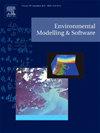Investigate the rainfall-runoff relationship and hydrological concepts inside LSTM
IF 4.6
2区 环境科学与生态学
Q1 COMPUTER SCIENCE, INTERDISCIPLINARY APPLICATIONS
引用次数: 0
Abstract
Recent studies have shown that LSTM performs well in runoff prediction in large sample regional modeling and can estimate hydrological concepts based on its internal information. However, compared to process-based models, it still produces erroneous predictions that violate the physical laws. To explore the reasons for the above phenomenon, this study analyzes the evolution of LSTM's performance in predicting runoff and estimating hydrological concepts when trained on a large basinscale dataset. Findings demonstrated that LSTM's representation of the rainfall-runoff relationship lags behind the formation of hydrological concepts. The representations of relations and concepts do not consistently increase with the number of training basins. There is a model that achieves the best representation of the rainfall-runoff relationship and hydrological concepts, ensuring physical consistency even under extreme conditions. These results suggest that LSTM, like process-based models, learns the rainfall-runoff relationship and hydrological concepts, but its confusion about these concepts may lead to inaccurate predictions.
研究降雨径流关系和LSTM内部的水文概念
近年来的研究表明,LSTM在大样本区域模型的径流预测中表现良好,并且可以基于其内部信息估计水文概念。然而,与基于过程的模型相比,它仍然会产生违反物理定律的错误预测。为了探究上述现象的原因,本研究分析了LSTM在大型流域数据集上训练后在预测径流和估计水文概念方面的性能演变。研究结果表明,LSTM对降雨-径流关系的表征滞后于水文概念的形成。关系和概念的表示并不总是随着训练盆地的数量而增加。有一个模型可以最好地表示降雨-径流关系和水文概念,即使在极端条件下也能确保物理一致性。这些结果表明,与基于过程的模型一样,LSTM学习了降雨-径流关系和水文概念,但它对这些概念的混淆可能导致预测不准确。
本文章由计算机程序翻译,如有差异,请以英文原文为准。
求助全文
约1分钟内获得全文
求助全文
来源期刊

Environmental Modelling & Software
工程技术-工程:环境
CiteScore
9.30
自引率
8.20%
发文量
241
审稿时长
60 days
期刊介绍:
Environmental Modelling & Software publishes contributions, in the form of research articles, reviews and short communications, on recent advances in environmental modelling and/or software. The aim is to improve our capacity to represent, understand, predict or manage the behaviour of environmental systems at all practical scales, and to communicate those improvements to a wide scientific and professional audience.
 求助内容:
求助内容: 应助结果提醒方式:
应助结果提醒方式:


